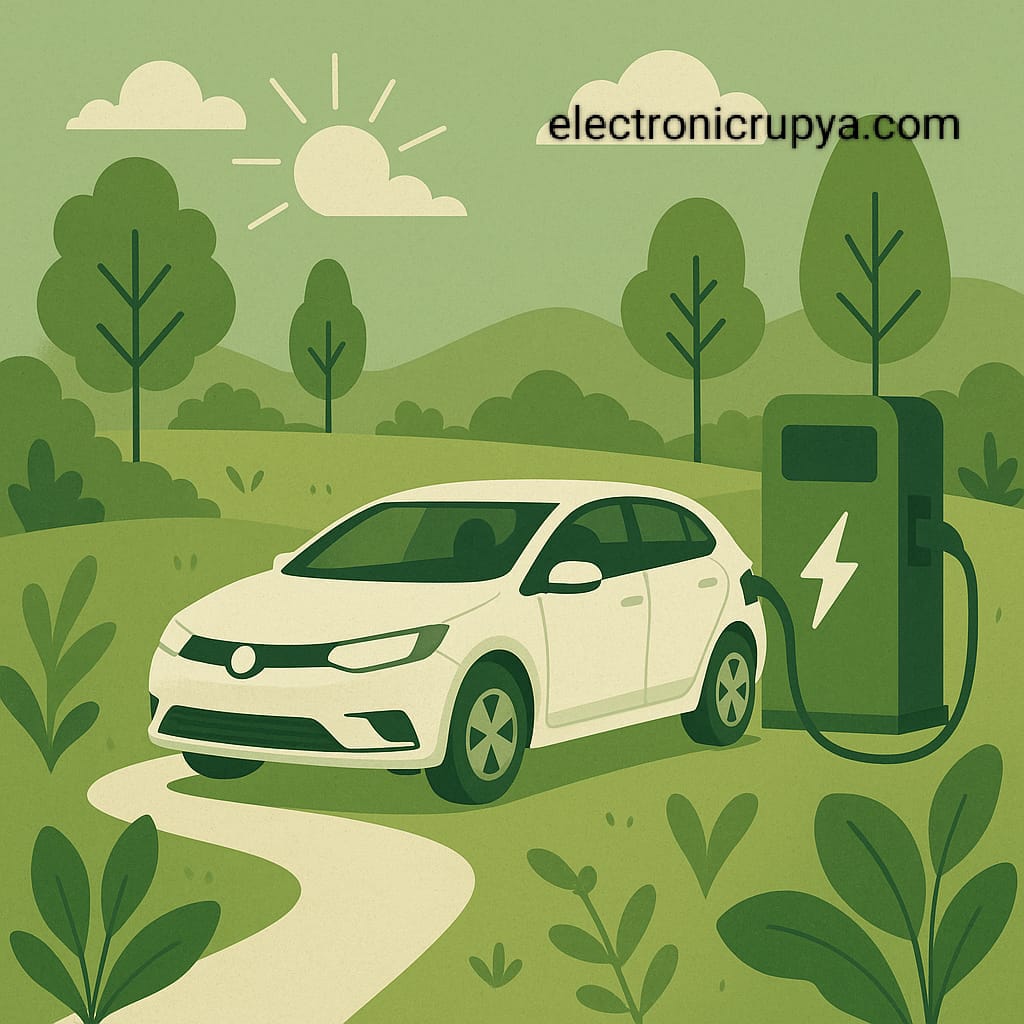Introduction

In recent years, India has found itself at a crucial juncture where rapid economic progress must be balanced with environmental responsibility. Among the various contributors to pollution and climate change, the transportation sector stands out as one of the largest.
Conventional petrol and diesel vehicles release enormous amounts of carbon dioxide, nitrogen oxides, and particulate matter into the atmosphere, all of which contribute to air pollution and global warming. However, a quiet revolution is beginning to reshape how India moves,the rise of electric vehicles.
Electric vehicles, or EVs, represent more than just a shift in fuel type; they symbolize a new way of thinking about mobility. Unlike traditional vehicles that rely on fossil fuels, EVs run on electricity, offering a cleaner, quieter, and more efficient driving experience.
With the growing awareness of climate change and the need for sustainability, EVs have become an important solution to reduce India’s carbon footprint. In cities like Delhi, Bengaluru, and Pune, where pollution levels regularly breach safe limits, electric mobility is being seen as a much-needed change.
The Indian go
vernment has played a critical role in promoting electric vehicles as part of its broader vision for sustainable development. Initiatives such as the Faster Adoption and Manufacturing of Hybrid and Electric Vehicles (FAME) scheme have offered subsidies and financial support to both EV buyers and manufacturers.
The second phase of this scheme, FAME II, has been particularly impactful by extending benefits to electric buses, two-wheelers, and commercial vehicles. These policies are aimed at not only making EVs more affordable but also encouraging innovation and local production.
Another positive step has been the development of EV-friendly state policies. States like Maharashtra, Tamil Nadu, and Delhi have introduced separate electric mobility policies offering tax rebates, exemption from road taxes, and incentives for setting up manufacturing units and charging stations.
These measures are intended to create a comprehensive ecosystem that supports the EV market from both the demand and supply sides. By making electric vehicles more accessible to the average consumer, the government is laying the foundation for long-term change.
However, despite these encouraging developments, the journey is far from easy. One of the biggest concerns for potential EV buyers is the lack of adequate charging infrastructure. Many people hesitate to switch to electric vehicles because they worry about running out of battery power during longer journeys.
This concern, known as range anxiety, remains a significant barrier to widespread EV adoption. In response, the government and private sector are working together to install more charging stations across highways, urban centers, and public parking lots. The success of electric mobility in India depends heavily on building a reliable and widespread charging network that can ease these concerns.
Affordability is another challenge. Although EVs are cheaper to run and maintain over time, the initial cost of purchasing one is still relatively high compared to traditional vehicles. The battery, which is the most expensive component of an electric vehicle, contributes significantly to this cost.
While subsidies and tax benefits have helped reduce the financial burden, more investment in battery technology and large-scale production is needed to make EVs truly affordable for the majority of Indians. The good news is that local manufacturing is expanding, and new battery technologies such as solid-state and lithium-iron phosphate are being developed, which could lower prices further in the coming years.
Environmental sustainability is another factor that must be considered. While EVs are often called “zero-emission” vehicles, their overall environmental impact depends on how the electricity used to charge them is generated.
If it comes from coal-based power plants, the carbon emissions are simply shifted from the tailpipe to the power station.For EVs to truly benefit the environment, India must continue its transition toward renewable energy sources like solar, wind, and hydroelectric power. This way, electric vehicles can run on clean energy from start to finish, amplifying their role in building a greener future.
economic opportunities due to Electric Vehicles
The rise of EVs is also creating new economic opportunities in India. The electric mobility sector is generating jobs in manufacturing, battery production, software development, and infrastructure services. Young engineers, entrepreneurs, and researchers are finding exciting careers in this emerging field. Startups are playing a key role in driving innovation, from designing efficient EV components to developing mobile apps for charging and navigation.
As the EV market grows, so does its potential to transform India’s economy into one that is more sustainable, tech-driven, and globally competitive.
Public awareness and acceptance are equally important in this transition. Many people still view electric vehicles with skepticism, often due to a lack of knowledge or exposure. Educational campaigns, pilot programs, and EV exhibitions can play a powerful role in changing mindsets. As more people experience the convenience and benefits of driving electric—such as quiet rides, low maintenance, and environmental friendliness—confidence in the technology will increase.
Healthier impacts on environment due to Electric Vehicles
India’s path toward electric mobility is not just about reducing emissions; it is about creating a cleaner, healthier, and more resilient society. By embracing electric vehicles, India has the opportunity to modernize its transportation system while protecting the environment for future generations.
The transition will not happen overnight, but with continued policy support, technological innovation, and public engagement, it is both achievable and necessary.
Electric vehicles are no longer just a futuristic idea, they are becoming a present day reality. As charging stations multiply, costs come down, and people grow more environmentally conscious, the electric vehicle movement in India is gaining real momentum.
This transformation will help the country reduce its dependence on imported oil, cut down on pollution related health problems, and position itself as a global leader in green innovation. The road ahead is still long, but with every electric car, bike, or bus that hits the streets, India moves one step closer to a cleaner, more sustainable tomorrow.
Conclusion
In conclusion, electric vehicles represent more than just a technological shift; they embody India’s commitment to a healthier environment and a forward-looking economy. With strong government support, public awareness, and growing infrastructure, EVs have the potential to reshape the nation’s transportation landscape.






